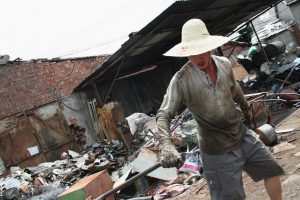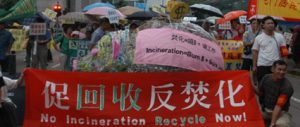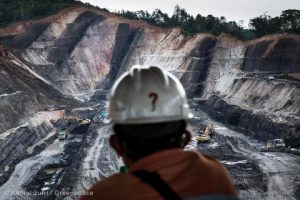On July 1, tough new standards for pollution from waste incinerators came into effect. The move is an attempt to end the conflict between communities across China and the nearby rubbish-burning plants they believe threaten their health and house prices. But experts on both sides of the debate are doubtful that pollution standards are the cause of opposition, or the key to ending it.
Waste incineration in China got started in the 1990s. In 2000 pollution standards for incinerators operating around Beijing were put in place, but local residents were still plagued by smoke and solid waste. Protests against these facilities have become more frequent in recent years.
To reduce pollution, the standards introduced this month tighten the limit for dioxin, a highly toxic substance, to the equivalent of 0.1 nanograms per cubic metre. This is 10 times stricter than the old standard of 1 nanogram, and equal to the EU’s standard. Standards for other pollutants such as heavy metals are mostly 30% tighter than under the previous regime.
The new rules appear to have satisfied neither the proponents nor opponents of rubbish-burning, however. The pro-incinerator camp says the old limits were already safe, and the new rules are simply there to make people feel safer. Opponents say the problem is the very idea of incineration and bad management.
“The 1.0 mg standard for dioxin already meant there was no impact on the surrounding environment,” said Zheng Minghui, a researcher at the Chinese Academy of Sciences’ Research Center for Eco-environmental Sciences. “We have the necessary technology to achieve the 0.1 mg standard, the toughest in the world. But the waste issue is a more general, social, problem,” he said.
Zheng is also employed as an expert by the UN Environmental Programme’s worldwide inventory of dioxin sources. He has visited numerous incinerators and met with locals and says those he has spoken care more about the presence of an incinerator per se than the specifics of its emissions. Incinerators currently have an image problem: they are connected to worsening environment and falling house prices.
Nie Yongfeng is deputy head of the solid waste committee at the Chinese Society for Environmental Sciences and a waste-burning advocate. He thinks the incinerator problem reflects a number of social issues. “For ordinary people, a house represents their savings and hard work. They won’t just sit by while it drops in value.” He says the government should be planning for these situations in advance.
Chen Liwen is against incinerators and has a plenty of complaints about how they are run. But most importantly she objects to the very idea of incineration.
Chen has worked for years at environmental NGO Nature University, working to get information on pollution from incinerators made available to the public. In June this year, just after the revised standard was published, she wrote a comment piece in the newspaper Southern Weekend describing the tougher rules as inadequate. Industrial and medical waste, as well as waste from water-treatment plants, could still be burned; frequency of monitoring for dioxins and heavy metals wasn’t high enough; and methods of dealing with ash contaminated with those pollutants did not have to be made public, she said.
Incinerators can be dangerous, and China suffers weak supervision, a lack of transparency, and frequent failures to use existing technology due to shortage of funds. Chen’s views on the new standards reflect these concerns, and she has little confidence that incinerator pollution will be brought under control. Instead, she wants to see a “waste management” approach – reducing the amount of waste through sorting and recycling, rather than just using landfill and incineration.
The waste disposal industry in China started up in the late 1980s, initially using mostly landfill and later incineration. Sorting and recycling has lagged behind. Chen disagrees with this approach, but it remains common. “The amount of waste is only going to increase, so landfill and incineration aren’t solutions,” she said.
Idle incinerators
Clashes over incinerators have been common in recent years, and as protests have spread and public opinion hardened, the government has often opted to halt construction or operation of these facilities. Long-standing confrontation has left waste to pile up, increasing future difficulties and costs, and ultimately further impacted on residents’ lives.
In Jiangsu province, east China, the city of Wuxi spent 1.5 billion yuan (US$242 million) on an incinerator which has sat idle for three years due to protests. Wuxi produces over 3,000 tonnes of waste a day, but its two existing incinerators can only dispose of two thirds of that. Its only landfill site is almost full, and there is no word as to where the extra waste will go.
Beijing’s situation is even worse. Construction of two incinerators has been halted due to protests, while the city continues to produce 18,400 tonnes of waste a day – only 10,400 tonnes of which it can dispose of. Most of its waste goes into landfill, but that requires 500 mu (0.3 square kilometres) of land a year. Overused landfill sites have a shorter lifespan, and pollution control is even harder in these spots.
Nie Yongfeng specialises in the study of solid-waste disposal, and supports incineration. But he is not optimistic about the protests. He fears China will see a repeat of the nightmare experienced by Italy a few years ago. Italian law requires that waste is disposed of locally, and as locals oppose incinerators Naples found itself with nowhere to put its waste once landfill sites were full. Around 100,000 tonnes of waste was left to pile up in the streets, and the government was twice forced to mobilise the army, in 2008 and 2011, to load it for transportation to a German incinerator.
Are there better ways of breaking China’s deadlock?
Zheng Minghui would like to see a system of community compensation and feedback: the government should address the concerns of those opposed to incinerators, building amenities such as parks to reduce their impacts. This is common in Taiwan. Meanwhile there should be serious, professional engagement with academics and NGOs opposed to incinerators, he said.
But Nie Yongfeng thinks it’s the public that needs to take greater responsibility, since it both produces the waste and benefits from its disposal. In some countries, he said, the public also make a small contribution to the cost of building incinerators. “If the public just objects, rather than makes compromises, the problem won’t get solved,” he said.
But all these solutions, including Chen’s choice of higher recycling rates, face similar problems. How to bring the public on board? And will the government take the initiative? Chen says that in many incinerator rows, including those in Likang in Guangzhou and Guodingshan in Wuhan, the public asked the government to step in and resolve disputes, but to no avail.
Even Nie admits his proposal won’t work, as “in China there’s no way to create a mechanism for dialogue and cooperation.”








